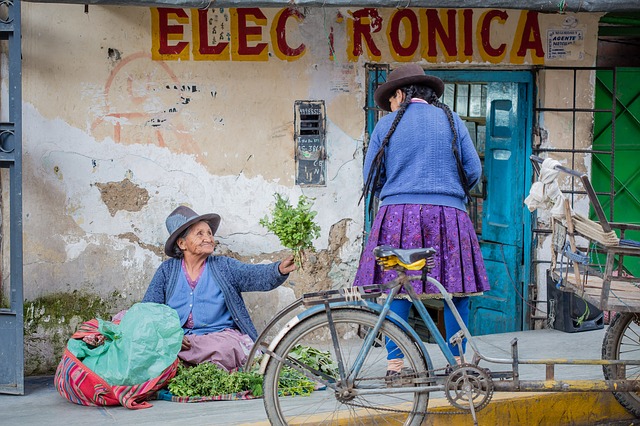Backpacking in Peru
Peru is generally known worldwide as the land of the Incas, but what does that say? That the Incas once lived here. That was the active people but also in other South American countries. Probably because of the famous Inca city of Machu Picchu, which today has degenerated into a sauteur tourist trap, the country is so called in the travel magazines.
But Peru has much more to offer than the buildings of the Incas. In the following we will go into it a little bit closer. But one can confidently call Peru the land of records. And now you surely want to know why?
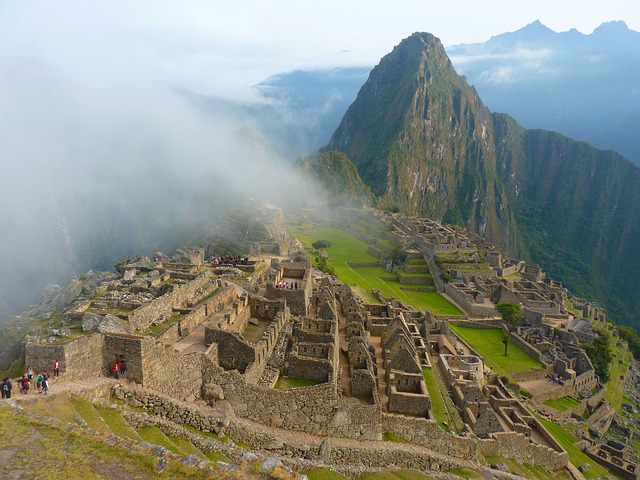
Backpacking in Peru – machu picchu
Backpacking in Peru
Peru is a real country of superlatives. Peru is home to an estimated 25,000 species, or 10% of the world’s population. 30% of them are endemic. The largest number of orchids in the world is found here – no less than 3000 species. There are also 462 mammal species, 1 815 bird species, 395 reptiles, 408 amphibians, 2000 fish species and 4000 butterfly species in Peru. And that’s not all. In which country can you choose from 250 different desserts on your journey alone? In Peru! And where is the highest tropical area in the world? Sure, in Peru!
To experience this, you have to go to the Nevado Huascarán, which is sometimes 6 768 meters high. And not to forget, the highest navigable lake on earth. Oh yes, and whoever thinks that Peru is a reatively small South American country, should be reminded that Colombia with 1 138 910 km2 and South Africa with 1 219 912 are already smaller than Peru. Only the Peruvian federal state Loreto in the northeast with the capital Iquitos is with 368 852 km2 already bigger than Germany. Quite nice chunk, this Peru.
However, there are no records to report with the numbers of visitors. So far, not more than 3 million visitors from all over the world come to Peru every year. Neuschwanstein Castle alone receives 1.4 million visitors per year. This shows how little Peru is frequented. And one can hardly believe it with this gigantic offer of cultural and geographical highlights plus affordable prices. From Germany, just over 50000 visitors arrive every year.
The Americans are crazy about Peru. Over 600,000 come from the USA every year. But most of the visitors are Latinos from the neighbouring countries. And it is worth it to travel through Peru. You can assume that your budget is not too much strained. Travelling in Peru is generally considered to be inexpensive. This also applies to accommodation and meals.
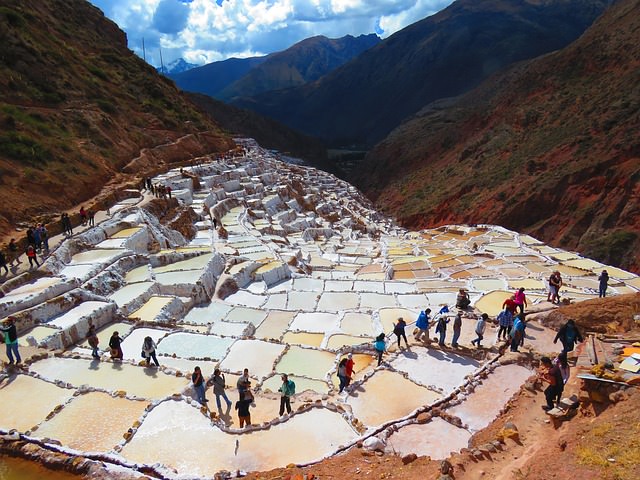
Backpacking in Peru – Paddy fields
But in spite of all the low prices, it is above all the varied travel and adventure possibilities that make a visit to the country worthwhile. You can go to the Andes at 6000 meters and higher, or you can go through the partly untouched zones of the Amazon region. Discover the old Inca buildings or look for older cultures in the oldest city of the continent Caral. Why not cruise the highest navigable lake in the world on Lake Titicaca?
Even more interesting might be a trip to the floating island Taquile of an indigenous tribe. On the Routa de Pisco you not only get the strong national drink in best quality from first hand, you also get to know more about the production, the country and the people. Try the Peruvian cuisine, which is one of the best in the world or enjoy the many sporting activities, including horse riding, rafting, surfing and much more.
Experience cultural diversity in Peru
If there is a multifaceted culture to experience somewhere, it is in Peru. If that’s surprising, given the geographical diversity that stretches from the deepest Amazon to the highest peaks of the Andes and on to the Pacific Ocean. There are forgotten and undiscovered indigenous tribes in Peru as well as isolated Andean people and fishermen who continue to follow their old traditions.
There is a modern Peru that is not closed to the latest technologies, as are the old, sunken cities. And this does not mean Machu Picchu of the Incas, which was a relatively young city, but Caral in the Valle de Supe, about 200 kilometres north of Lima. The age of the city is estimated at 5,000 years. At that time, people in Europe still lived in the most primitive dwellings.
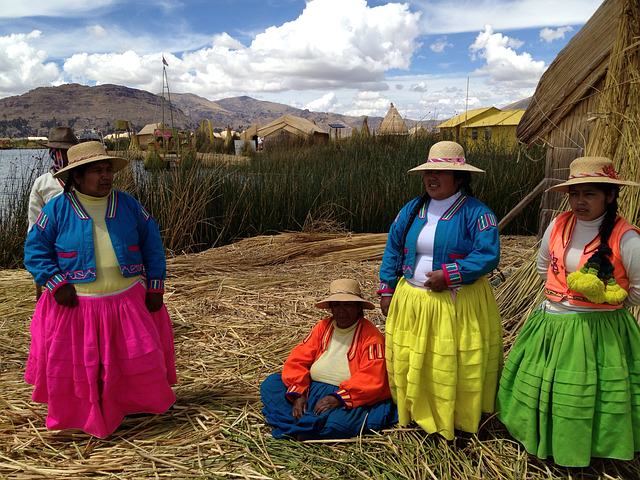
Backpacking in Peru – chichi kaka
The young culture of Peru
As you travel through Peru, you will realize that you are dealing with a people based on indigenous and Creole roots through the different faces and skin colors, as well as the fashionable currents. The Creole roots come from the ancestors of Africa, Asia and especially Italian Europeans.
And, of course, all these immigrants brought with them their customs and traditions, which today are expressed in dances such as the famous Diablada, drinks such as pisco and food, and handicrafts. With regard to the delicacies and culinary delights, we come immediately to another record. According to the Guinness Book of Records, Peru has the most typical dishes in the world.
There are almost 500 recognized. So you would have to take a year and a half to try all the dishes once. Provided you eat a different one every day. The multifaceted cultural diversity of Peruvian cuisine is expressed above all in the recipes of the dishes. Depending on the region, you can try barren Andean cuisine, lavish Amazon food and high-protein seafood cuisine. And if you like potatoes, you can choose from more than 5000 different varieties – another record.
Backpacker Route in Peru
Peru you should never, unless you have a lot of time, travel down in one. There is just too much to see. It is best to divide the country into different parts, which you then leave one after the other. You can do this for the Andes, the lowlands and the Amazon. If you only want to see the most important of the country, do the classic tour.
You can check off Peru like so many others in one week and only visit the most important points in it. The classic Peru visit includes among other things. Peru is a well known dog for backpackers in South America. I won’t be able to tell you much new about the route.
But there are corners in Peru that are not as well known as Machi Picchu and co. Quite spontaneously I think of Huaraz, for example. It is really very cool for treks and hikes to high lakes and mountains. A personal tip from me: Treat yourself to a few days Inca-Free in between. Someday this will get on your nerves like the temples in Asia.
Classic route in Peru
- 2-3 days Lake Titicaca
- 2-3 days Lima with its gastronomic variety
- 2-3 days Inca capital Cuzco and Machu Picchu
- 1 day Nasca Lines
- 1 day Arequipa (UNESCO World Heritage)
- 1 day Colca Canyon
If you have more time available, then it is also worth integrating the lesser known destinations into the trip.
The Backapcker Intensive Peru itinerary
- 2-3 Days Titikaka Lake & Floating Islands
- 1 day Vicuñas, Alpacas and Lamas from Arequipa to Puno
- 1 day visiting Ballestas Islands
- 2-3 Days Cuzco – Capital of the Incas
- 1 day Pisac and Sacred Valley of the Incas
- 1 day Machu Picchu
- 4-5 days Amazonas
- 1 day Nasca Lines
- 1 day Arequipa (UNESCO World Heritage)
- 2-3 days Kuelap, ChanChan, Caral – the old Peru
- 1 day 3000 year old Chavín de Huántar Culture
- 1 day Caballitos de totora – Boats from Reed
- 1 day scissor dance in Ayacucho
- 1 day mountaineering Huaraz
- 2-3 Days Manu National Park
- 2-3 days Llanganuco Lagoon
- 2-3 days Colca Canyon
Travel time in Peru
The best travel time in Peru depends on what you want to do. In the Amazon jungle there are different climatic conditions than in the Andes at an altitude of 4,000 meters in the Andes. You can take bathing things as well as winter sports equipment with you. The rainy season in Peru is considered to be the months from November to April.
It is most pleasant on average in the months from May to October with long dry phases. Right at the top in the Andes regions, there is a year-round high mountain climate with a lot of rain that also falls snow. On the Altiplano you should always have thick clothes with you. This is valid for the whole year. The Peruvian jungle has a tropical climate.
Backpacker Budget in Peru
Peru is not the cheapest country on the South American continent, but by far not the most expensive either. What travel costs do you have to calculate per day for your stay in Peru? That’s a question that can’t be answered in general, because everyone has different requirements. Some travel bibles preach that as a cheap traveller or backpacker, you have to reckon with a daily rate of approximately 12 – 20 euros.
This includes undemanding overnight stays, bus trips and cheap food. Those who like it a little more comfortable should already plan 50 to 70 Euro for the travel budget. But as already said, there is nothing in it. The entrance to Machu Picchu alone costs 50 dollars. That ruins the cut. Here a small list with the prices, which could result so.
- Meal Restaurant cheap 3 Euro
- 3 course menu middle class restaurant 20 Euro
- Combo Meal McDonalds 4 Euro
- Beer (0.5 liter draught) 1,3 Euro
- Cappuccino (regular) 2 Euro
- Coke/Pepsi (0.33 liter bottle) 0,6 Euro
- One-way ticket (local transport) 0,4 Euro
- Taxi Start (Normal Tariff) 1,1 Euro
Running and hitchhiking, perhaps by bike, are the cheapest ways to travel – not only in Peru. You can also do that. But if you prefer a comfortable bus, you should have a look at the homepage of the bus portal. There you can find out when which bus departs where. The homepage is available in the three languages Spanish, English and French. Also the cost question is clarified there. Bus driving is not expensive in Peru.
As an example here
- Flores Tacna – Lima about 30 dollars
- Flores Lima – Tumbes 30 dollars
- Bus Cifa Tumbes – Guayaquil 6 dollars
Train travel in Peru
You can also travel by train in Peru. Especially the route from Lima to Huancayo is often covered by train. Here you can let the landscape pass you in a luxury train with a view carriage. The distance is the hammer, because you will be crossed 69 tunnels and 58 bridges with the tour over the Andes through and. The highest point of the route is at 4781 meters. Here you can book your ticket.
Domestic flights in Peru
Those who have less time to bridge the gigantic distances in Peru and have a little more noise in their travel budget, can take a scheduled flight inland. You can find the best deals on the homepage of Vuelosnacionales.pe or at atrapalo.pe.
Backpacker Accommodations in Peru
In Peru you will find every kind of accommodation. You can rent a simple or luxurious apartment in the city or stay in a star hotel depending on your budget. Some of the best hotels on the continent are located in Peru. Usually, however, the prices are affordable. Whether you choose a 1 or 5 star hotel is up to you. There is enough choice. For the night in a 4 star hotel you should plan around 50 euros. Which is relatively cheap for the service. If you don’t feel like living in a dorm with 10 people, then it’s worth taking a room for 20 to 30 euros in a 3-star hotel for two. In some cities, some hotels are located in residential areas. These are then called hostels. But they are not. Rather, it is a kind of descent for lovers. According to Hostelworld, the average city price for a bed in a dorm is:
- Cusco 8 Euro
- Lima 10 Euro
- Arequipa 8 Euro
- Puno 8 Euro
- MachuPicchu 10 Euro
- Huacachina 13 Euro
- Mancora 12 Euro
- Paracas 7 Euro
- Ollantaytambo 12 Euro
- Nazca 7 Euro
You can also look around Peru for bed and breakfast, apartments and campsites. A bed in a B&B is often not more expensive than a hostel.
Camping in Peru
Peru is not exactly the camping country, but you will find a campsite here and there. You can camp at reasonable prices. However, you should stick to the conventions and not leave your dirt in the nature everywhere. Especially in the vicinity or in most national parks you will always find camping opportunities.
Usually at least a basic equipment is available. You will also find a campsite in Quintalala, very close to Cusco. Camping is also possible in Ancash and at Lake Titicaca. Even at the most important sights like in Kualep or near various museums you can find camping opportunities.
Backpacker Trips, Tips & Highlights in Peru
The best travel spots in Peru are well known – at least once the absolute hammer highlights. One thing is for sure, there is something for every taste. Whether surfing or beauty at the Pacific beaches or a climbing tour in the Andes or a jungle trip in the Amazon, everything is possible. Numero uno and internationally probably the most famous destination quite clearly. MachuPicchu.
If you want, you can book a ticket online to the architectural wonder of the Incas. Those interested in culture have to go to Trujillo to Huacas del Sol y de la Luna and to Chiclayo to the famous Señor de Sipan. There are still the mystical Nazca lines near Nazca and Palpa, which are dated to the time from 700 B.C. to 200 A.D..
But in order to see them properly, one has to be in the air. A must is the visit of the Colca Canyon at the Colca River. It is less the river that irritates, it is the gigantic gorge and above all the majestically circling condors that fascinate. A side trip to the Uros Islands in Lake Titicaca, as well as a visit to the highest navigable lake of the world, is also part of the program.
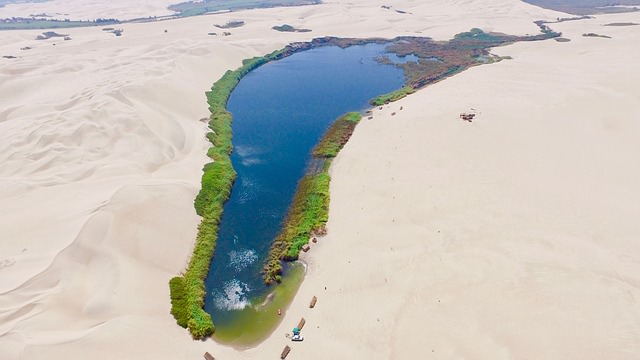
Backpacking in Peru – Ica
Peru’s artisan markets worth seeing
Fascinating works of art can be found in almost every village on any small market. There you can also make the best deals. But have a look at the market in the Valle del Urubamba at the Feria de Písac, which always takes place on Sundays. In Junín, the Feria de Huancayo on the Plaza de Huamanmarca is also always full on Sundays. In Lima you should visit the MercadoInca in the Av. La Marina. And the Feria de Petit Thouars awaits your visit in the Av. Petit Thouars in Miraflores.
The unknown travel highlights in Peru
Allegedly there are more than 3000 destinations in Peru, of course there are also many highlights. You can only leave them if you take a very long time. But if you want to experience something different than the above mentioned Lonely Planet and package holiday destinations in Peru, you have to be off the beaten path. In Spanish you have to search under lugares secretos or pocos conocidos. On the adventure pages in Peru you will always find exciting travel destinations. Why don’t you go to the wild Río Cañete and dare a crazy rafting tour on the river? The best place to start is in Lunahuaná.
Also worthwhile is a detour to the waterfalls Catarata de Tirol and Catarata de Bayoz. Pure dense jungle and crystal clear water invite you to swim and linger. Everyone goes to Huancayo. Those who want to get away from the tourist route drive to the Reserva Nacional de Junín that is 200 kilometres away. At an altitude of more than 4000 metres, you stand on a hillless plain that extends over 50000 ha.
Cool also the flamingos. Remember also the keywords Pozuzo and Oxapampa. You will find the original Peru in the middle of the jungle. There you can spend the night with the native tribes. Trekking is on the program in the Parque Llanachaga Chemillén.
One of the most adventurous bridge crossings you’ll ever make is a walk across the puente Q´eswachaka, which was built according to the traditional Inca style from plants. If you don’t want to make a river tour from the guide book through the Amazon with an old river freighter, you have to fight your way into the bush to Pucallpa. From Lima with the bus 21 hours. Then it goes with one of the Henry boats through the jungle to Iquitos – or vice versa pure comfort – in the hammock.
Food & Drinks in Peru
If it is worth discovering a cuisine in South America, it is Peruvian cuisine. It is one of the most diverse not only in the region, but also in the world. Highly decorated chefs from the best restaurants around the globe come to the country every year to inspire themselves with the masters of local cuisine.
Andean cuisine, once declared dead, is reborn thanks to world-famous dishes such as ceviche. Not everyone likes roasted guinea pigs, but in Peru they are what we call grilled sausage. And when a pig or beef is slaughtered in Europe, hardly anyone asks for it.
What makes the cuisine in Peru so unique are not only the many elements from African, Chinese, Japanese, Italian, French and indigenous cuisine, but also the various ingredients, especially from the Altiplano and the Amazon regions, which make the taste so unique. In addition to the staple foods corn and potatoes, you can also try the pseudo grain quinoa, which is a real vitamin and mineral bomb.
On the coast, you can try leaked seafood dishes such as Chupe de camarones, a creamy soup made from prawns, potatoes and more, and in the mountains you should try the many potato dishes. With a choice of 5000 different types of potatoes, there is always plenty of opportunity to fill your stomach with different flavours. Especially in the capital Lima you can try the Cocina Novoandina in trendy restaurants, where old and new merge harmoniously.
You must try Ceviche (raw fish/calamari marinated in lime juice), Chocloconqueso (cooked corn on the cob with cheese), Cuychactado (roasted guinea pig) OlluquitoconCharqui (tuberous Olluco with dried lama meat), Pollo a labrasa (grilled chicken). Chicken marinated and cooked on the fire, served with French fries). A Pisco is recommended for washing down, as a brandy or a PiscoSour, a cocktail, as an aperitif or digestif. Who orders a Chicha, gets a kind of beer from corn. The Inca Kola is a must and a Matetee quietly the thirst and stimulates the circulation.
Drinks in Peru
The most famous drink of Peru is probably the Pisco Sour. But the stuff is also very pure. There are also beautifully packaged souvenir bottles, sometimes bound in leather. Then you have to try the numerous delicious freshly squeezed fruit juices. Chicha Morada is made from corn. There is even freshly squeezed frog juice. But you shouldn’t drink it. If you are completely flat, then a Cha de Coca will surely get you back on your feet. Coca tea works wonders, even with altitude sickness. The Peru variant of Coca Cola is Inca Cola. It is yellow like piss.
Backpacker Visa and Vaccinations in Peru
According to the Federal Foreign Office, entry requirements for German citizens are possible with the following travel documents. Entry is possible for German citizens with the following documents:
- Passport: Yes
- Provisional passport: Yes, US visa required for travel via the USA.
- Identity card: No
- Temporary identity card: No
Visa
You can stay up to 183 days in Peru. When you enter Peru, you will receive an entry card (“Tarjeta Andina de Migración”). Sometimes you will have to present a return or onward ticket, although this does not comply with the official entry regulations.
An important tip:
If you arrive by land, make sure to have the date of entry documented by a stamp of the border authority in your passport, otherwise you may be under stress when leaving the country.
Vaccination and medical advice
When travelling to the designated yellow fever endemic areas of Peru, especially for the entire Peruvian Amazon region, a timely vaccination is recommended to all travellers from the age of 9 months. Coming from Peru, the vaccination can be required for onward travel to a third country. According to information from the Peruvian immigration authorities, proof of a valid yellow fever vaccination is currently not required either when entering Peru from a yellow fever area (often the neighbouring states) or when entering Germany directly. The usual tropical diseases such as malaria and dengue are known in Peru.

